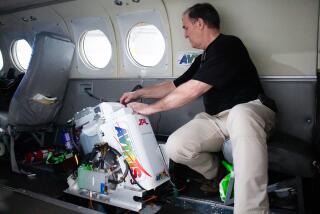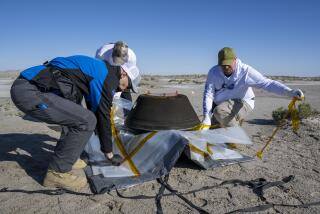Shuttle Crew Captures Satellite Carrying Ozone Data
- Share via
KENNEDY SPACE CENTER, Fla. — The space shuttle Discovery’s astronauts deftly snagged a satellite loaded with valuable data about Earth’s ozone layer on Saturday, accomplishing their final objective in orbit.
Scientists at Kennedy Space Center cheered and congratulated one another once the satellite was back on board.
“Great job, Discovery,” Mission Control in Houston said.
The crew of six is due back with the satellite on Monday.
Nine days after releasing it to measure atmospheric gases, the astronauts closed in on the satellite using the same kind of approach that will be needed for the future space station. Then payload commander Jan Davis slowly reached out with Discovery’s 50-foot robot arm and grabbed the probe as the spacecraft sped 180 miles above the Pacific Ocean just north of New Zealand.
In another station-building test, Davis relied on remote camera views instead of a direct line of sight to lower the boxy, 7,700-pound satellite into the shuttle cargo bay.
During its free flight, the German-built satellite collected enough data to fill nearly half a ton of computer disks, said Robert Conway, a Naval Research Laboratory scientist in charge of its ultraviolet telescope.
The satellite scanned the atmosphere as low as four miles and as high as 115 miles, as far north as the northern fringes of Canada and as far south as the Antarctic Circle.
Virtually all the information was stored in the satellite.
Only a tiny percentage was transmitted to ground controllers--just enough to show that the instruments were working properly.
It will be at least a month before the satellite is unloaded and Conway and other scientists get their data.
As part of the ozone study, NASA and the German space agency launched more than 70 small rockets and weather balloons and flew a plane equipped with atmospheric monitors over Europe.
The launches and flights were timed to coincide with the satellite measurements.
More to Read
Sign up for Essential California
The most important California stories and recommendations in your inbox every morning.
You may occasionally receive promotional content from the Los Angeles Times.










